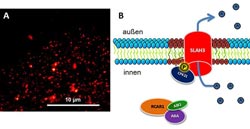Nanodomains Made Visible

Nanodomains in the membrane of the genetic model organism Arabidopsis thaliana, made visible with high resolution microscopy. The domains are discernible as sharply delineated areas (red, left). Among other things, they provide a platform for the ABA signaling pathway, via which the plants sense drought stress and take countermeasures. Picture: Ines Kreuzer<br>
Plants are generally firmly rooted in the ground so that they cannot just move to a different place when the conditions become too dry or uncomfortable in any other way. Therefore, they must be alert to environmental changes and react appropriately.
When the conditions are favorable, the root absorbs nutrients and life-sustaining water. Above the surface of the ground, the shoot adjusts to the current light conditions, performs photosynthesis and produces components for growth, development and reproduction.
Under stress, the plants switch over from this standard program to survival mode. For this purpose, they need the ability to sense stress factors – such as heat, drought or the presence of pathogens – and to take appropriate action. They are able to do this with the help of sensors, which are each connected to a specific network.
Interconnected platforms in the membranes
“According to current knowledge, the cell membranes contain numerous tiny platforms, where certain signaling proteins interact. To some extent, these platforms possess preset interconnections. Depending on the respective signal, they are then reconfigured,” explains Dr. Ines Kreuzer, a plant biologist at the University of Würzburg. Because these membrane platforms are so tiny, they are also known as nanodomains.
Reconfiguration of the nanodomains observed
As reported in the journal PNAS, Kreuzer's study group showed for the first time that the components of the drought stress signaling pathway occupy such nanodomains. In cooperation with Professor Gregory Harms at Wilkes University in Pennsylvania (USA), they were also able to trace the change in the domain composition induced by the hormone abscisic acid (ABA) under the laser microscope.
The ABA hormone is used to communicate changes in the water status between different parts of the plant. In dry conditions, high ABA levels ensure that the plant reduces its loss of water to the minimum.
Several signaling proteins involved
The team of the young Würzburg researcher identified several signaling proteins in the nanodomains as main components of the ABA signaling pathway. Kreuzer: “We are talking about the ion channel SLAH3, which is activated by the protein kinase CPK21. This kinase is controlled by the protein phosphatase ABI1. As soon as the receptor recognizes the presence of the ABA hormone, it deactivates the phosphatase and sends out the kinase to activate the ion channel. The opening of the ion channel converts the 'water shortage' signal into a flow of ions – an electrical response, in other words.”
Phosphatase as “doorkeeper”
In this process, the nanodomains are a kind of “meeting place”, where the reactants are given the opportunity to meet. In the absence of the drought stress hormone ABA, the phosphatase ensures that the ion channel and the kinase are no longer allowed into the membrane domains – there is no cellular response. “The processing of the hormone signal is obviously regulated on the basis of the fact that certain proteins either have or don't have access to special membrane areas, in which mechanism the phosphatase seems to perform the function of a 'doorkeeper', as Kreuzer summarizes.
The next steps of the research
Further studies are intended to show how the process in the nanodomains impacts on the nucleus. It is conceivable that drought tolerance genes are activated there, ensuring the survival of the plant even when there is a shortage of water.
Ines Kreuzer and her study group conduct research at the Department of Botany I – Molecular Plant Physiology and Biophysics of the University of Würzburg, headed by Professor Rainer Hedrich. Their studies are funded by the German Research Foundation within the Research Training Group 1342 (Molecular and Functional Analysis of Lipid-Based Signal Transduction Systems).
Arabidopsis nanodomain-delimited ABA signaling pathway regulates the anion channel SLAH3. Fatih Demir, Claudia Horntrich, Jörg O. Blachutzik, Sönke Scherzer, Yvonne Reinders, Sylwia Kierszniowska, Waltraud X. Schulze, Gregory S. Harms, Rainer Hedrich, Dietmar Geiger, Ines Kreuzer, PNAS, April 29, 2013, doi 10.1073/pnas.1211667110
Contact persons
Dr. Ines Kreuzer, Department of Botany I – Molecular Plant Physiology and Biophysics, University of Würzburg, T +49 (0) 931 31-86103, ifuchs@botanik.uni-wuerzburg.de
Prof. Dr. Rainer Hedrich, Department of Botany I – Molecular Plant Physiology and Biophysics, University of Würzburg, T +49 (0) 931 31-86100, hedrich@botanik.uni-wuerzburg.de
Media Contact
More Information:
http://www.uni-wuerzburg.deAll latest news from the category: Life Sciences and Chemistry
Articles and reports from the Life Sciences and chemistry area deal with applied and basic research into modern biology, chemistry and human medicine.
Valuable information can be found on a range of life sciences fields including bacteriology, biochemistry, bionics, bioinformatics, biophysics, biotechnology, genetics, geobotany, human biology, marine biology, microbiology, molecular biology, cellular biology, zoology, bioinorganic chemistry, microchemistry and environmental chemistry.
Newest articles

“Nanostitches” enable lighter and tougher composite materials
In research that may lead to next-generation airplanes and spacecraft, MIT engineers used carbon nanotubes to prevent cracking in multilayered composites. To save on fuel and reduce aircraft emissions, engineers…

Trash to treasure
Researchers turn metal waste into catalyst for hydrogen. Scientists have found a way to transform metal waste into a highly efficient catalyst to make hydrogen from water, a discovery that…

Real-time detection of infectious disease viruses
… by searching for molecular fingerprinting. A research team consisting of Professor Kyoung-Duck Park and Taeyoung Moon and Huitae Joo, PhD candidates, from the Department of Physics at Pohang University…





















